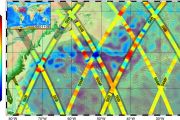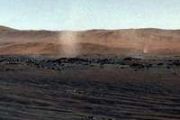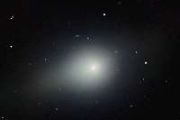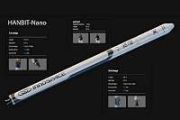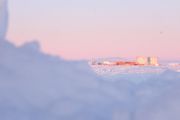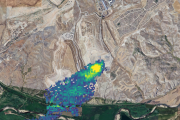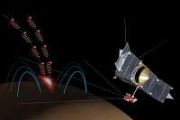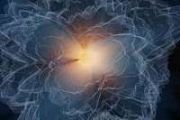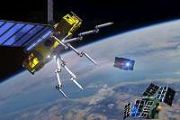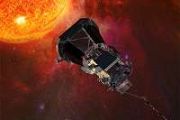
Copernical Team
Tiny asteroid to pass close by Earth today
 On Thursday, Jan. 26, a small near-Earth asteroid will have a very close encounter with our planet. Designated 2023 BU, the asteroid will zoom over the southern tip of South America at about 4:27 p.m. PST (7:27 p.m. EST) only 2,200 miles (3,600 kilometers) above the planet's surface and well within the orbit of geosynchronous satellites.
There is no risk of the asteroid impacting Earth. Bu
On Thursday, Jan. 26, a small near-Earth asteroid will have a very close encounter with our planet. Designated 2023 BU, the asteroid will zoom over the southern tip of South America at about 4:27 p.m. PST (7:27 p.m. EST) only 2,200 miles (3,600 kilometers) above the planet's surface and well within the orbit of geosynchronous satellites.
There is no risk of the asteroid impacting Earth. Bu Hawkeye 360 lunches Cluster 6 satellites aboard inaugural Rocket Lab Electron flight from Virginia
 HawkEye 360 Inc., the world's leading commercial provider of space-based radio frequency (RF) data and analytics, announced that its Cluster 6 next-generation satellites have successfully deployed to orbit aboard the inaugural Rocket Lab Electron flight from Launch Complex 2 at Virginia Space's Mid-Atlantic Regional Spaceport within NASA's Wallops Flight Facility. Communication with the satellit
HawkEye 360 Inc., the world's leading commercial provider of space-based radio frequency (RF) data and analytics, announced that its Cluster 6 next-generation satellites have successfully deployed to orbit aboard the inaugural Rocket Lab Electron flight from Launch Complex 2 at Virginia Space's Mid-Atlantic Regional Spaceport within NASA's Wallops Flight Facility. Communication with the satellit Webb spies Chariklo ring system with high-precision technique
 In an observational feat of high precision, scientists used a new technique with NASA's James Webb Space Telescope to capture the shadows of starlight cast by the thin rings of Chariklo. Chariklo is an icy, small body, but the largest of the known Centaur population, located more than 2 billion miles away beyond the orbit of Saturn. Chariklo is only 160 miles (250 kilometers) or ~51 times smalle
In an observational feat of high precision, scientists used a new technique with NASA's James Webb Space Telescope to capture the shadows of starlight cast by the thin rings of Chariklo. Chariklo is an icy, small body, but the largest of the known Centaur population, located more than 2 billion miles away beyond the orbit of Saturn. Chariklo is only 160 miles (250 kilometers) or ~51 times smalle China Compound Eye facility to monitor asteroids for planetary defense
 China plans to use its new China Compound Eye facility in Chongqing to observe asteroids and Earth-like planets hundreds of millions of kilometers away as part of its planetary defense work. The Chongqing Innovation Center under the Beijing Institute of Technology, which designed and built the China Compound Eye, recently released its first 3D radar map of an area of moon craters taken by the hi
China plans to use its new China Compound Eye facility in Chongqing to observe asteroids and Earth-like planets hundreds of millions of kilometers away as part of its planetary defense work. The Chongqing Innovation Center under the Beijing Institute of Technology, which designed and built the China Compound Eye, recently released its first 3D radar map of an area of moon craters taken by the hi NASA safety system enables Rocket Lab launch from Wallops
 A revolutionary NASA flight safety system has enabled a new era of space transportation with the successful flight of Rocket Lab USA's Electron rocket Jan. 24, from NASA's Wallops Flight Facility in Virginia.
This mission, the first Electron launch from the United States, was enabled by NASA's work in developing the NASA Autonomous Flight Termination Unit (NAFTU), a critical piece of fligh
A revolutionary NASA flight safety system has enabled a new era of space transportation with the successful flight of Rocket Lab USA's Electron rocket Jan. 24, from NASA's Wallops Flight Facility in Virginia.
This mission, the first Electron launch from the United States, was enabled by NASA's work in developing the NASA Autonomous Flight Termination Unit (NAFTU), a critical piece of fligh UAE astronaut says not required to fast during Ramadan on ISS
 Emirati astronaut Sultan al-Neyadi said Wednesday that he will not be required to fast during Ramadan while on his upcoming space mission.
The 41-year-old will become the first Arab astronaut to spend six months in space when he blasts off for the International Space Station (ISS) next month aboard a SpaceX Falcon 9 rocket.
Neyadi, NASA's Stephen Bowen and Warren Hoburg and Russia's Andr
Emirati astronaut Sultan al-Neyadi said Wednesday that he will not be required to fast during Ramadan while on his upcoming space mission.
The 41-year-old will become the first Arab astronaut to spend six months in space when he blasts off for the International Space Station (ISS) next month aboard a SpaceX Falcon 9 rocket.
Neyadi, NASA's Stephen Bowen and Warren Hoburg and Russia's Andr Isar Aerospace and Spaceflight Inc sign launch agreement to service global market
 European launch service company Isar Aerospace, and U.S.-based Spaceflight Inc., the leading global launch services provider, announced they have signed a multi-launch services agreement. Under the agreement, Spaceflight secured one dedicated launch in 2026 to a sun-synchronous orbit taking off from Andoya, Norway and an option to add an additional dedicated launch to occur in 2025.
"We've
European launch service company Isar Aerospace, and U.S.-based Spaceflight Inc., the leading global launch services provider, announced they have signed a multi-launch services agreement. Under the agreement, Spaceflight secured one dedicated launch in 2026 to a sun-synchronous orbit taking off from Andoya, Norway and an option to add an additional dedicated launch to occur in 2025.
"We've SwRI-led Lucy team announces new asteroid target
 NASA's Lucy spacecraft will add another asteroid encounter to its 4-billion-mile journey. On Nov. 1, 2023, the Southwest Research Institute-led Lucy mission will get a close-up view of a small main belt asteroid to conduct an engineering test of the spacecraft's innovative asteroid-tracking navigation system.
The Lucy mission was already on course to break records by its planned visit of n
NASA's Lucy spacecraft will add another asteroid encounter to its 4-billion-mile journey. On Nov. 1, 2023, the Southwest Research Institute-led Lucy mission will get a close-up view of a small main belt asteroid to conduct an engineering test of the spacecraft's innovative asteroid-tracking navigation system.
The Lucy mission was already on course to break records by its planned visit of n Perseverance marks 1 Martian Year at Jezero
 Perseverance and the team recently celebrated one Martian year (668 sols or 687 Earth days) on the Red Planet while continuing to offload sample tubes at the "Three Forks" depot location. The celebration also marked the end of the prime mission at Jezero as the team transitions into the extended mission phase and sets their sights on the delta top.
It has been a fitting celebration and end
Perseverance and the team recently celebrated one Martian year (668 sols or 687 Earth days) on the Red Planet while continuing to offload sample tubes at the "Three Forks" depot location. The celebration also marked the end of the prime mission at Jezero as the team transitions into the extended mission phase and sets their sights on the delta top.
It has been a fitting celebration and end NASA validates revolutionary propulsion design for deep space missions
 As NASA takes its first steps toward establishing a long-term presence on the Moon's surface, a team of propulsion development engineers at NASA have developed and tested NASA's first full-scale rotating detonation rocket engine, or RDRE, an advanced rocket engine design that could significantly change how future propulsion systems are built.
The RDRE differs from a traditional rocket engi
As NASA takes its first steps toward establishing a long-term presence on the Moon's surface, a team of propulsion development engineers at NASA have developed and tested NASA's first full-scale rotating detonation rocket engine, or RDRE, an advanced rocket engine design that could significantly change how future propulsion systems are built.
The RDRE differs from a traditional rocket engi 


